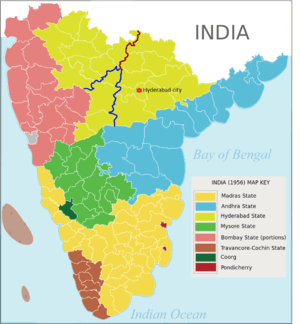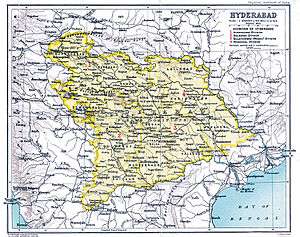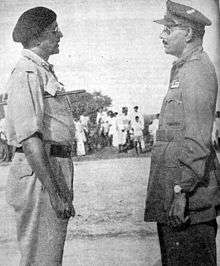Hyderabad State (1948–56)
17°00′N 78°50′E / 17.000°N 78.833°E
| Hyderabad State (1948–1956) | |||||
| State of India | |||||
| |||||
 | |||||
| History | |||||
| • | Hyderabad State formed from Hyderabad Princely State | 1948 | |||
| • | Reorganized and renamed Andhra Pradesh | 1956 | |||
| States of India since 1947 | |||||

Hyderabad State was a state in Independent India, formed after the accession of the princely state of Hyderabad into the Indian Union on 24 November 1949. It existed from 1948 to 1956.
Following the States Reorganisation Act Hyderabad State was merged with Andhra State in 1956 and renamed Andhra Pradesh.[1]
History
Operation Polo is the code name of the Hyderabad "police action" in September 1948, by the newly independent India against the Hyderabad State.[2] It was a military operation in which the Indian Armed Forces invaded the Nizam-ruled princely state, annexing it into the Indian Union.[3]
At the time of Partition in 1947, the princely states of India, who in principle had self-government within their own territories, were subject to subsidiary alliances with the British, giving them control of their external relations. In the Indian Independence Act 1947 the British abandoned all such alliances, leaving the states with the option of opting for full independence. However, by 1948 almost all had acceded to either India or Pakistan. One major exception was that of the wealthiest and most powerful principality, Hyderabad, where the Nizam, Osman Ali Khan, Asif Jah VII, a Muslim ruler who presided over a largely Hindu population, chose independence and hoped to maintain this with an irregular army recruited from the Muslim aristocracy, known as the Razakars.[4]:224 The Nizam was also beset by the Telangana uprising, which he was unable to subjugate.[4]:224
In November 1947, Hyderabad signed a standstill agreement with the dominion of India, continuing all previous arrangements except for the stationing of Indian troops in the state. However, with the rise of militant razakars, India found it necessary to station Indian troops and invaded the state in September 1948 to compel the Nizam.[5] Subsequently, the Nizam signed an instrument of accession, joining India.[6]
The operation led to massive violence on communal lines. The Indian prime minister Jawaharlal Nehru appointed a commission known as the Sunderlal Committee. Its report, which was not released until 2013, concluded that "as a very reasonable & modest estimate...the total number of deaths in the state...somewhere between 30,000 & 40,000."[7] Other responsible observers estimated the number of deaths to be 200,000 or higher.[8]
Military Governor

After the Annexation into the Indian Union, Major General J. N. Chaudhuri who led Operation Polo stayed on as Military Governor till December 1949.
The state witnessed Mulkhi agitation in 1952 by the locals after a government jobs meant for the locals were given to non-locals.
Rajpramukh
Telangana movement Hyderabad State had its last Nizam, HEH Mir Osman Ali Khan (1886–1967) as Rajpramukh from 26 January 1950 to 31 October 1956.
First Appointed Chief Minister
After the Annexation of Hyderabad State into India, M. K. Vellodi was appointed the Chief Minister of the state on 26 January 1950. He was a Senior Civil servant in the Government of India. He administered the state with the help of bureaucrats from Madras state and Bombay state.
The Nizam was given the ceremonial position of "Raj Pramukh" or "Governor".
First Elected Chief Minister
In the first State Assembly election in India, 1952, Dr. Burgula Ramakrishna Rao was elected Chief minister of Hyderabad State. During this time there were violent agitations by some Telanganites to send back bureaucrats from Madras state, and to strictly implement 'Mulki-rules'(Local jobs for locals only), which was part of Hyderabad state law since 1919.[9]
Districts of Hyderabad State
Administratively, Hyderabad State was made up of sixteen districts, grouped into four divisions:
- Aurangabad Division included Aurangabad, Beed, Nanded, and Parbhani districts;
- Gulbarga Division included Bidar District, Gulbarga, Osmanabad, and Raichur District;
- Gulshanabad Division or Medak Division included Atraf-i-Baldah (Hyderabad), Mahbubnagar district, Medak district, Nalgonda district (Nalgundah), and Nizamabad districts, and
- Warangal Division included Adilabad, Karimnagar, and Warangal districts (present Khammam district was part of Warangal district).
Linguistic Reorganization
In 1956 during the Reorganisation of the Indian States based along linguistic lines, the Telugu-speaking region of the state of Hyderabad State was merged with Andhra State. The Marathi speaking region was merged with Bombay state and Kannada speaking region with Mysore State.
The States Reorganisation Commission (SRC) was not in favour of an immediate merger of Telugu speaking Telangana region of Hyderabad state with Andhra state, despite their common language. Para 378 of the SRC report said One of the principal causes of opposition of Vishalandhra also seems to be the apprehension felt by the educationally backward people of Telangana that they may be swamped and exploited by the more advanced people of the coastal areas.
Andhra state and Hyderabad State were merged to form Andhra Pradesh on 1 November 1956, after providing safeguards to Telangana in the form of Gentlemen's agreement. But in June 2014, Telangana re-emerged as a separate state. Hyderabad City will continue to be the capital of both Andhra Pradesh and Telangana for 10 years.
Chief Ministers of Hyderabad State
- Major General Choudhary – Military Governor 1948–49
- M. K. Vellodi – 1950–1952 (appointed by Government of India)
- Burgula Ramakrishna Rao – 1953–1956 (elected)
References
- ↑ "States Reorganization Act 1956". Commonwealth Legal Information Institute. Archived from the original on 16 May 2008. Retrieved 1 July 2008.
- ↑ "Hyderabad Police Action". Indian Army. Retrieved 2014-09-13.
- ↑ B. Cohen (2007). Kingship and Colonialism in India's Deccan: 1850-1948. Springer. pp. 159–161. ISBN 978-0-230-60344-8.
- 1 2 Barbara D. Metcalf; Thomas R. Metcalf (2006). A Concise History of India (2nd ed.). Cambridge University Press. ISBN 978-0521682251.
- ↑ Sherman, Taylor C. (2007). "The integration of the princely state of Hyderabad and the making of the postcolonial state in India, 1948 – 56" (PDF). Indian economic & social history review. 44 (4): 489–516. doi:10.1177/001946460704400404.
- ↑ Chandra, Mukherjee & Mukherjee 2008, p. 96.
- ↑ Noorani 2014, Appendix 15: Confidential notes attached to the Sunderlal Committee Report, pp. 372-373
- ↑ Smith 1950, p. 46.
- ↑ "Mulki agitation in Hyderabad state". Hinduonnet.com. Retrieved 2011-10-09.
- Thomson, Mike (24 September 2013). "Hyderabad 1948: India's hidden massacre". BBC. Retrieved 24 September 2013.
Bibliography
- Benichou, Lucien D. (2000), From Autocracy to Integration: Political Developments in Hyderabad State, 1938-1948, Orient Blackswan, ISBN 978-81-250-1847-6
- Hyder, Mohammed (2012), October Coup, A Memoir of the Struggle for Hyderabad, Roli Books, ISBN 8174368507
- Hodson, H. V. (1969), The Great Divide: Britain, India, Pakistan, London: Hutchinson
- Menon, V. P. (1956), The Story of Integration of the Indian States (PDF), Orient Longman
- Muralidharan, Sukumar (2014). "Alternate Histories: Hyderabad 1948 Compels a Fresh Evaluation of the Theology of India's Independence and Partition". History and Sociology of South Asia. 8 (2): 119–138. doi:10.1177/2230807514524091.
- Noorani, A. G. (2014), The Destruction of Hyderabad, Hurst & Co, ISBN 978-1-84904-439-4
- Raghavan, Srinath (2010), War and Peace in Modern India, Palgrave Macmillan, ISBN 978-1-137-00737-7
- Smith, Wilfred Cantwell (January 1950), "Hyderabad: Muslim Tragedy", Middle East Journal, 4 (1): 27–51, JSTOR 4322137
- Zubrzycki, John (2006), The Last Nizam: An Indian Prince in the Australian Outback, Australia: Pan Macmillan, ISBN 978-0-330-42321-2
External links
- Picture of VII Nizam with Sardar Patel after his surrender
- From the Sundarlal Report, Frontline, 3–16 March 2001
- Exclusive Sundar Lal report on Hyderabad police action, Deccan Chronicle, 30 November 2013.
- In the Nizam's dominion, by Bret Wallach, University of Oklahoma
- A Blog by Narendra Luther on Operation Polo
- Armchair Historian – Operation Polo (Monday, 18 September 2006) – Contributed by Sidin Sunny Vadukut – Last Updated (Monday, 18 September 2006)